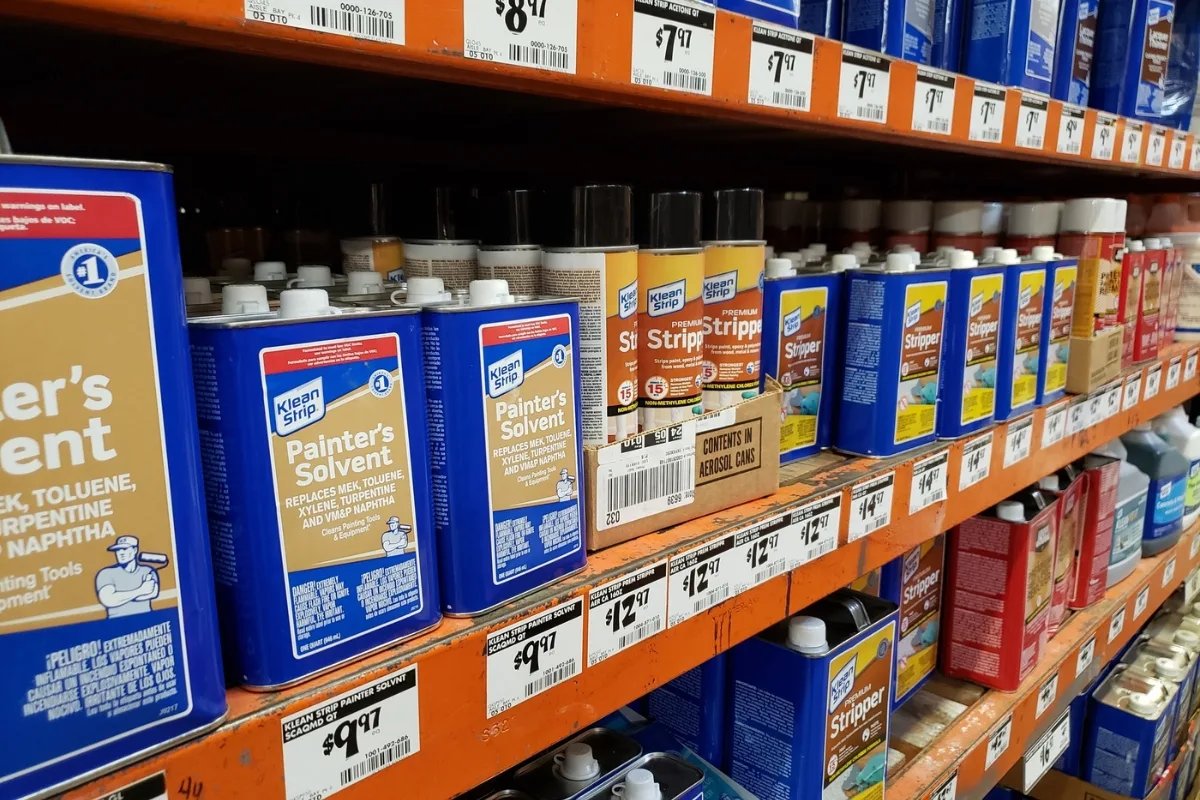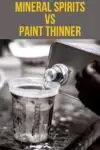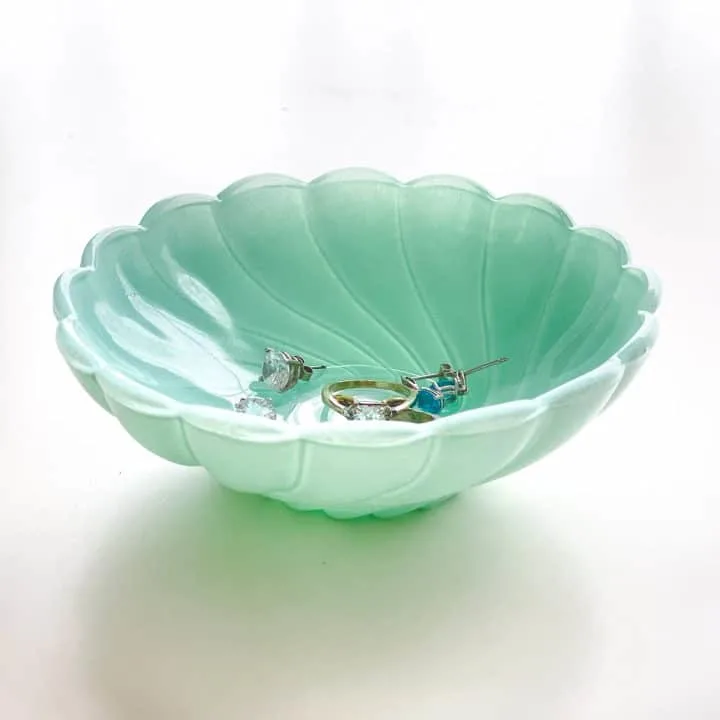Discover the differences between mineral spirits vs paint thinner in our detailed comparison, and learn the ideal choice for your projects.

Are you wondering about the differences between mineral spirits and paint thinner? Are they the same thing? When should I use which one?
The difference between these two products can be tricky to define. Why? Because they have a lot of overlap and are derived from the same thing. With that said, there are some technical differences between the two that are worth considering.
In this article, we'll dive into the nitty-gritty of these two popular solvents, exploring their similarities, differences, and how to choose the right one for your project.
This post contains affiliate links for your convenience. Purchases made through these links may earn me a small commission at no additional cost to you. Please visit my disclosures page for more information.
Differences Between Paint Thinners and Mineral Spirits
Mineral spirits and paint thinners are both petroleum-based solvents, but with slight differences. Mineral spirits have a milder odor and are less toxic, making them a go-to for many DIY projects. Paint thinners, on the other hand, are more potent and versatile, often used for heavy-duty tasks.
Here's a quick look at the differences, so you know which one to grab when you're confronted with an aisle of products at the store.

Mineral spirits:
- Used to thin paint (can work for oil-based paints and some latex paint)
- Slightly more expensive than paint thinners
- A more refined substance
- Less smelly (you can find some nearly odor free mineral spirits)
- Fewer VOCs than other paint thinners
- Requires less quantity to clean
- Use for cleaning up paint/stains/finishes
Paint thinner:
- Used for cleaning and thinning oil-based paint and stains
- Less refined than mineral spirits
- Stronger odor
- More VOCs generally
- Less expensive
Let’s look at each of these products in more detail.
What are Mineral Spirits?
Mineral spirits, also known as white spirits or mineral turpentine, is a petroleum-based solvent commonly used in painting, cleaning, and degreasing applications. It is a clear, colorless liquid with a mild odor and lower toxicity compared to other solvents.
In painting, mineral spirits are often used to thin oil-based paints, clean brushes, and remove paint spills. Oil and water don't mix, so if you spill oil-based paint, you’ll need mineral spirits to clean up the mess.
When Should You Use Mineral Spirits?
Mineral spirits are used for oil-based paints and finishes in the same way that water is used for water-based paints and finishes. You can learn more about water based vs oil based primer here if you're not sure of the differences.
Here are several uses for mineral spirits:
- Thinning oil-based paints: Mineral spirits reduce the paint's viscosity, making it easier to apply and ensuring a smooth finish.
- Cleaning brushes and tools: After working with oil-based paints or varnishes, mineral spirits can be used to clean brushes, rollers, and other painting tools.
- Removing paint spills and stains: Accidents happen, and when they do, mineral spirits can save the day. They are effective at breaking down and lifting oil-based paint stains from surfaces like wood, metal, or concrete.
Mineral spirits can also be used for general clean-up, when you need to remove oily residue.
How Do You Use Mineral Spirits?
Using mineral spirits is relatively simple, but it's important to take the necessary safety precautions. Here's a few things to keep in mind:
- Preparation: Work in a well-ventilated area to minimize inhalation of fumes. Wear protective gloves, safety glasses, and old clothes to protect your skin and eyes. Also, have a clean, dry cloth or sponge ready for application.
- Thinning oil-based paints: Pour the paint into a mixing container and add mineral spirits gradually while stirring. Start with a small amount, such as a 4:1 paint-to-solvent ratio, and adjust as needed to achieve the desired consistency.
- Cleaning brushes and tools: Pour a small amount of mineral spirits into a container, enough to cover the bristles or tool parts. Soak the brushes or tools in the solvent for a few minutes, then gently agitate them to remove paint residues. Rinse the brushes with warm, soapy water and lay them flat to dry.
- Removing paint spills and stains: Dampen a clean cloth or sponge with mineral spirits, then gently rub the affected area until the paint dissolves. For stubborn stains, you may need to apply more solvent and use a bit of elbow grease. Wipe the area clean with a dry cloth when the stain is gone.
- Disposal: Dispose of used mineral spirits according to local regulations, as improper disposal can harm the environment. Most communities have designated facilities for hazardous waste disposal.
Remember to always read and follow the manufacturer's instructions on the mineral spirits container, as there may be specific guidelines for safe and effective use.
What is Paint Thinner?
Paint thinner is a general term for a variety of petroleum-based solvents used to thin or dilute paint and clean painting equipment. It is a clear liquid that evaporates quickly and has a strong odor.
While the term "paint thinner" is often used interchangeably with "mineral spirits," paint thinners are usually more potent than mineral spirits. However, it also tends to have a stronger odor and higher toxicity, which can make it less desirable for some users or applications.
When Should You Use Paint Thinners?
You should consider using paint thinner instead of mineral spirits in the following situations:
- Stronger solvent needed: Paint thinner is more potent than mineral spirits, making it suitable for heavy-duty tasks or when you need a stronger solvent. If you're working with a paint, varnish, or lacquer that isn't dissolving or thinning well with mineral spirits, paint thinner may be a more effective option.
- Faster evaporation: Paint thinner generally evaporates more quickly than mineral spirits, which can be helpful for speeding up drying times. However, keep in mind that faster evaporation can also make the paint more challenging to work with, as it may dry too quickly or become tacky.
- Compatibility: Some paint products, especially lacquers and certain varnishes, may specifically recommend using paint thinner as a solvent. Always read and follow the manufacturer's instructions on the paint container, as using the wrong solvent can lead to poor results or even damage the surface you're working on.
- Cost considerations: In some cases, paint thinner might be more affordable than mineral spirits. If you're on a tight budget and need a solvent for a one-time project, paint thinner could be a more cost-effective choice.
Remember that paint thinner has a stronger odor and higher toxicity compared to mineral spirits, so ensure proper ventilation and protective gear when using it. Additionally, always follow the manufacturer's instructions and safety guidelines.
How Do You Use Paint Thinners?
Paint thinners are used the same way as mineral spirits, but there are a few things you should know to ensure you stay safe and get the best results.
Store Paint Thinners in a Safe Area
With paint thinner, there are two primary concerns – the fumes, and the flammability. First, you want to ensure that it is kept out of reach of children or pets.
Second, paint thinner can be flammable. You don’t want to use this product near any open flames.
Also, keep in mind that paint thinner is usually less refined than mineral spirits. This means that paint thinner is often smellier and will release more harmful VOCs. For this reason, it’s best to only use it in a ventilated area.
Pay Attention to Dilution Ratios
If you’re planning to dilute oil paint with paint thinners, then ensure you read the packaging instructions for both products. Don’t just start mixing things and hope for the best!
In general, you should start by mixing 4 ounces of paint thinner with 1 gallon of paint. However, consult the manufacturer for the best ratio for your brand of paint.
Keep Rags and Cups Separate
There might be a time when you’re painting one area with oil-based paint and another area with water-based paint. Or perhaps you’re switching back and forth from one day to the next.
If you’re using cups or rags for both projects, don’t forget which one is for the paint thinner and which is for the water. Otherwise, you might accidentally apply the paint thinners to the wrong area, risking damage (and more work!)
As you can see, the choice between mineral spirits vs paint thinner ultimately depends on your specific needs and preferences. While both are petroleum-based solvents used for thinning paints and cleaning tools, they have their differences.
With the right knowledge and precautions, you'll be able to tackle your painting projects confidently and achieve professional results. Happy painting!







